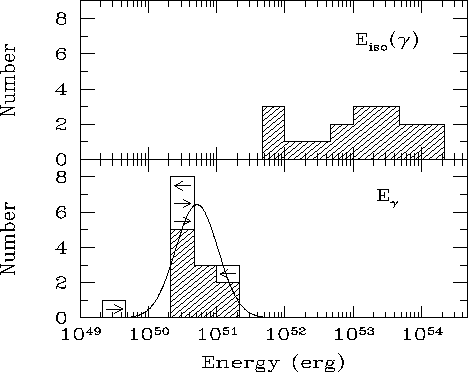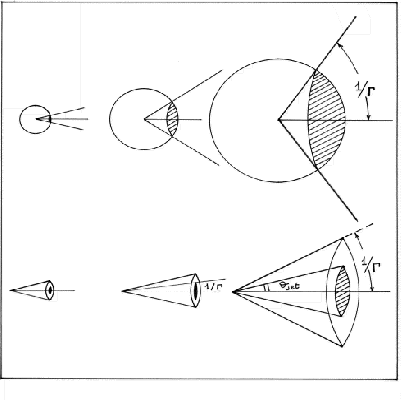



Next: Theoretical Models
Up: The Afterglow Emission
Previous: GRB-SN Connection
Contents
One of the most impressive properties of the bursts is the huge amount of
energy released (fig. ![[*]](crossref.png) ), typically ranging
between few
), typically ranging
between few  and few
and few  ergs (isotropic emission).
ergs (isotropic emission).
Figure:
Energy Distribution of GRBs with known redshift in two cases:
isotropic emissions (top panel), and geometry-corrected for jet-like
emissions (bottom panel). The non-isotropic case tightly clusters the
distribution around
 erg. (From [Frail et al., 2001]).
erg. (From [Frail et al., 2001]).
 |
Assuming isotropic emission, the case of GRB990123 is really impressive:
only in the gamma-ray domain, it released
 ergs, i.e.
about twice the rest mass of the Sun.
If one supposes a jet-like emission, the energy requirements are reduced
by a factor of
ergs, i.e.
about twice the rest mass of the Sun.
If one supposes a jet-like emission, the energy requirements are reduced
by a factor of
 with respect to the
spherical emission (
with respect to the
spherical emission ( is the solid angle subtended by the emission
cone). On this subject, searches for the so-called ``orphan afterglows'',
corresponding to GRBs beamed away from our line of sight, have been performed,
only providing limits on the beaming factor.
is the solid angle subtended by the emission
cone). On this subject, searches for the so-called ``orphan afterglows'',
corresponding to GRBs beamed away from our line of sight, have been performed,
only providing limits on the beaming factor.
Figure:
The two different cases of spherical and jet-like emission:
the visibility cone, defined by the time-evolving bulk Lorentz factor,
should distinguish at late times between the two cases. (From [Ghisellini, 2001]).
 |
Fig. ![[*]](crossref.png) nicely shows what kind of observable effects should be
measured in the afterglow light curve for the two different cases of spherical
and jet-like emission: the relativistic beaming produces a visibility cone with
an opening angle of
nicely shows what kind of observable effects should be
measured in the afterglow light curve for the two different cases of spherical
and jet-like emission: the relativistic beaming produces a visibility cone with
an opening angle of  . In the early phases,
. In the early phases,
 (see Fireball
Model section) and the two cases cannot be distinguished; as the afterglow evolves,
(see Fireball
Model section) and the two cases cannot be distinguished; as the afterglow evolves,
 decreases; when it is
decreases; when it is
 (
( is the opening
angle of the jet), the afterglow light curve in the jet-like geometry should break
and decline more rapidly, since an edge effect occurs. Indeed, the break in the
light curve is due also to another effect: the lateral spreading of the jet, since
the ejecta, encountering more surrounding matter, decelerate faster than it happens
for the spherical case. The clearest evidence for a jet can be found in the sharp
achromatic break in the light curve of GRB990510.
Also the detection of polarization for this burst ([Covino et al., 1999]) seems to agree
with the jet-like emission. Recently, [Frail et al., 2001], have tried to estimate the
opening angles
is the opening
angle of the jet), the afterglow light curve in the jet-like geometry should break
and decline more rapidly, since an edge effect occurs. Indeed, the break in the
light curve is due also to another effect: the lateral spreading of the jet, since
the ejecta, encountering more surrounding matter, decelerate faster than it happens
for the spherical case. The clearest evidence for a jet can be found in the sharp
achromatic break in the light curve of GRB990510.
Also the detection of polarization for this burst ([Covino et al., 1999]) seems to agree
with the jet-like emission. Recently, [Frail et al., 2001], have tried to estimate the
opening angles  for a set of bursts with known redshifts, whose break
times
for a set of bursts with known redshifts, whose break
times  (or limits) have been estimated; the set of
(or limits) have been estimated; the set of  coming out
includes the range
coming out
includes the range
 with a strong concentration around
with a strong concentration around  .
The energy distribution derived is surprisingly more clustered with respect
to the spherical case, around
.
The energy distribution derived is surprisingly more clustered with respect
to the spherical case, around
 ergs.
ergs.




Next: Theoretical Models
Up: The Afterglow Emission
Previous: GRB-SN Connection
Contents
Cristiano Guidorzi
2003-07-31

![[*]](crossref.png) ), typically ranging
between few
), typically ranging
between few 

![[*]](crossref.png) nicely shows what kind of observable effects should be
measured in the afterglow light curve for the two different cases of spherical
and jet-like emission: the relativistic beaming produces a visibility cone with
an opening angle of
nicely shows what kind of observable effects should be
measured in the afterglow light curve for the two different cases of spherical
and jet-like emission: the relativistic beaming produces a visibility cone with
an opening angle of